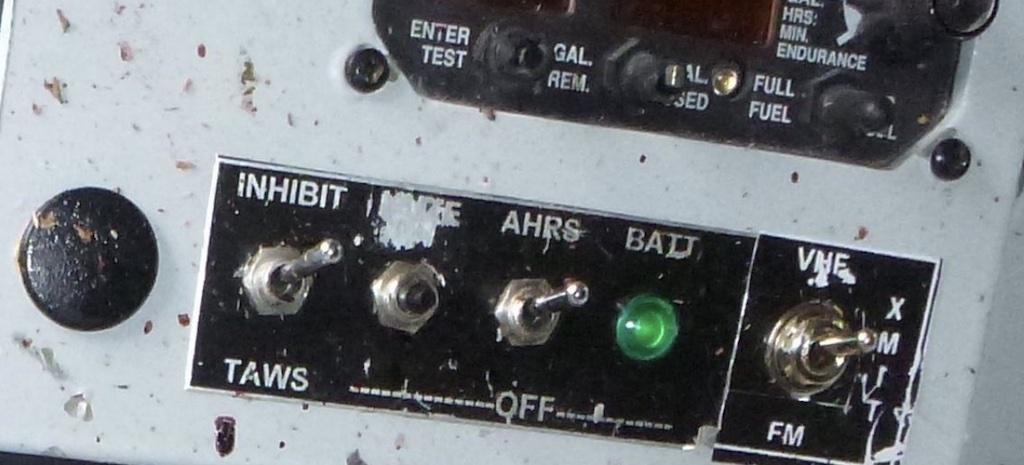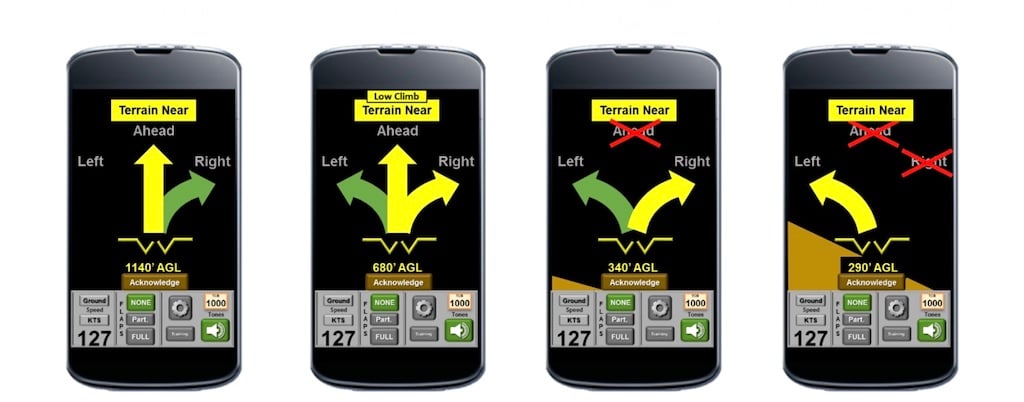
TAWS inhibit switch involved in the 2015 Ketchikan accident.
On June 25, 2015, a Promech Air de Havilland DHC-3, registration N270PA, collided with terrain about 24 nm east-northeast of Ketchikan, Alaska. The pilot and all eight passengers were killed and the airplane was destroyed.
At the time of the accident, Ketchikan International Airport (KTN) was reporting wind 130° at 15 kts gusting to 23 kts with visibility six miles in moderate rain and mist. The lowest cloud layer was at 800 ft., with a broken deck at 1,200 ft. and an overcast covering at 2,700 ft. AGL. Weather cameras pointed toward the accident area showed higher ridge elevations were obscured by clouds.
The flight was a Part 135 sightseeing tour being conducted under visual flight rules. It could legally operate with two miles visibility under a 1,000 ft. ceiling (14 CFR 135.205).
The single-turbine-powered Otter was required to be equipped with a Class B terrain alerting and warning system (TAWS). The Chelton FlightLogic electronic flight instrument system (EFIS) had an auditory and visual caution/warning system that would warn the pilot if he was approaching too close to terrain. However, when investigators examined the wreckage, they found the system was disabled by an “Inhibit” toggle switch.
It wasn’t the first time that Alaska pilots had experienced a controlled flight into terrain (CFIT) accident with their TAWS system turned off. It happened in Aleknagik, Alaska, in August 2010, and in Saint Mary’s, Alaska, in November, 2013. Just after the Promech Air accident, a SeaPort Airlines Cessna 207A had a CFIT accident in Juneau, Alaska, with its TAWS inhibited, and while the NTSB was investigating the Ketchikan crash, another Part 135 airplane struck a mountain near Togiak, Alaska, with its TAWS inhibited.
Pilots at Promech Air and other Alaska Part 135 operators complained that the TAWS equipment put out continuous warnings at altitudes below 700 ft. AGL, and these warnings were distracting when they were flying at 500 ft., or sometimes lower. As a result, they were inhibiting the warning system most of the time.
To address this problem the NTSB wrote Safety Recommendation A-17-35. The board asked the FAA to find ways to provide effective terrain warnings while minimizing nuisance alerts for single-engine airplanes operating at low altitudes. The FAA assigned the problem to a group called the General Aviation Joint Steering Committee (GAJSC). Standards organization RTCA also convened a special committee (SC-231) to develop solutions and consider changes to standards affecting TAWS. The committee met with Alaskan operators in 2019 to further understand their practical needs.
In 2020, the FAA issued an exemption from 14 CFR 135.154(b)(2), TAWS, to members of the Alaskan Air Carriers Association. It allowed those nine carriers to operate single-engine, turbine-powered aircraft with six to nine passenger seats in Alaska under VFR conditions using Class C TAWS with a display, rather than Class B TAWS. Class C TAWS with a display maintained the necessary level of safety while reducing nuisance alerts, the agency said.
In 2021, the FAA told the NTSB it was focusing on two changes: preventing the pilot from tampering with proper TAWS functioning (the inhibit function); and developing TAWS lateral escape maneuvers commonly needed in Alaska. They also changed the TAWS alerting threshold to 500 ft. AGL.
Vertical And Lateral Escape Maneuvers

In January of 2023 the FAA said it was working with the General Aviation Manufacturers Association (GAMA) to develop software to override and un-inhibit TAWS. The FAA also was working with NASA to develop guided terrain escape maneuvers incorporated into TAWS.
A look at RTCA’s 2020 white paper on TAWS gives an idea of how the software will work. Current TAWS logic commands a straight ahead climb even when terrain varies or there are icing conditions above. The new focus is on combined vertical and lateral escape maneuvers. The software will have to compute a set of flight paths, read terrain elevation data from a suitable source, compare the altitude of the predicted escape paths to the terrain elevation data, and choose the best action. High resolution, high integrity terrain data will be needed.
The white paper provided some illustrations. Red lines indicated flight paths with possible terrain conflicts and green lines indicated feasible escape paths. A yellow line would indicate the only remaining viable path when terrain clearance is in doubt. There may need to be new voice call outs, like “terrain ahead” and “terrain left” or “pull up left, pull up left.” The visual display will have to be enhanced. Real time performance assessments will also be needed.
Escape Maneuver Display

NASA has developed a “Viable Escape Maneuver Display” (VEMD) for flight crew situational awareness. The display is shown as if it were a progression of maneuver options depicted on a cellphone or tablet.
Twenty-four out of 39 Part 135 CFIT accidents that have taken place in the U.S. since 2010 have been in Alaska. While the FAA, RTCA, GAJSC and NASA were working on technical solutions to CFIT accidents, there were six more fatal Part 135 CFIT accidents in Alaska. The latest, in 2021, was a DHC-2 Beaver in Ketchikan. As a reciprocating-powered airplane, it was not even required to have a TAWS. That has to change.
If an airplane is carrying passengers on a commercial sight-seeing flight, it needs to have state-of-the-art terrain avoidance technology. This is especially true in Alaska, and the sooner, the better.





